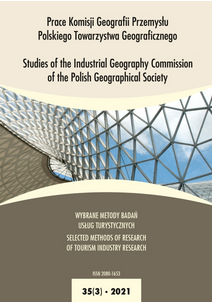Ocena sytuacji rozwojowej i funkcjonalnej stacji narciarskich - przykład polskich Karpat
Evaluation of the development and functional situation of ski stations - the example of the Polish Carpathian Mountains
Author(s): Kinga KrzesiwoSubject(s): Regional Geography, Methodology and research technology, Present Times (2010 - today), Tourism
Published by: Wydawnictwo Uniwersytetu Komisji Edukacji Narodowej w Krakowie
Keywords: development; methodology; Polish Carpathians; ski stations; ski tourism; tourist function;
Summary/Abstract: The aim of this study is to present the evaluation of the development and functional situation of 19 ski stations located in the Polish Carpathians. To achieve the aim of the study, a comparative analysis of the transport capacity of ski lift devices and the number of beds in 2012 and 2020 in the studied ski stations was carried out, as well as the classification of these localities according to the length of tourists stay, the indicator determining the place of tourism in the functional structure of the locality, the indicator showing the reception capacity of the locality in the winter season and the indicator showing the place of ski tourism in the structure of tourist function of ski station. In the Polish Carpathians, there is a qualitative development of ski infrastructure. In 2012–2020, ski infrastructure developed the most in Szczyrk, Białka Tatrzańska, Krynica and Tylicz. The largest increase in the number of beds occurred in the ski stations located in the Podhale region, especially in Zakopane, Białka Tatrzańska and Bukowina Tatrzańska. Nine groups of ski stations were distinguished, differing in the level of equipment in the infrastructure for downhill skiing, the level of accommodation development, the time specificity of tourist traffic in the winter season and functional relations with tourist destinations located in their vicinity. Among them, the top places are taken by: Zakopane, Krynica, Szczyrk, Wisła, Białka Tatrzańska, and Bukowina Tatrzańska.
Journal: Prace Komisji Geografii Przemysłu Polskiego Towarzystwa Geograficznego
- Issue Year: 35/2021
- Issue No: 3
- Page Range: 259-276
- Page Count: 18
- Language: Polish

